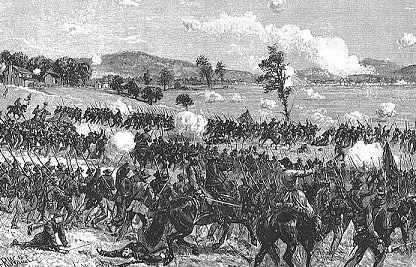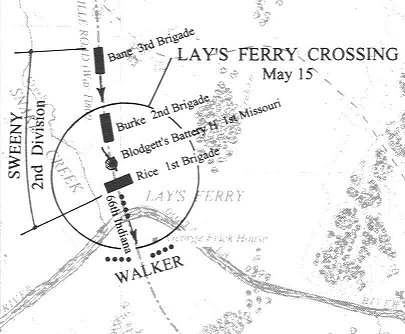 The
Battle of Lay's Ferry...
The
Battle of Lay's Ferry...
Although this sideshow to the Battle of Resaca was in some respects a comedy of errors, these critical events ultimately decided the fate of the Confederate stronghold north of the Oostanaula River.
Close this window to return to the Friends of Resaca web site.
The road from Snake Creek Gap split in 1864. One portion turned east toward Resaca. The other headed south to the Oostanaula River, crossing the river at a place called Lay's Ferry about 5 miles downstream from Resaca. On May 13, 1864, General Sherman ordered that pontoon bridges be sent to the ferry through the gap for the following purpose:
"As soon as I know the pontoons have started down the road I will send all the cavalry here to cross the bridge, and will order all of General Schofield's army to move as soon as it is demonstrated that Johnston has actually retreated." (O.R., Correspondence from Sherman to General Thomas, Part 4, p. 161)
Sherman planned to use two pontoon bridges at Lay's Ferry to follow the Confederate retreat in case General Johnston chose not to fight at Resaca. However, when it became obvious that Johnston did, in fact, plan to resist the Northern advance at Resaca, Sherman was forced to change his plans. Instead of sending his cavalry and Schofield to outflank the Southerners, on May 14 Sherman ordered that General Thomas W. Sweeny's division be detached from General McPherson's Army of the Tennessee with the purpose of crossing the river and threatening Johnston's communications. Sweeny eventually succeeded in this, but not before a great deal of skirmishing and miscommunication took place.
The ferry was guarded by a detachment of Confederate cavalry from General William T. Martin's division along with a battery of artillery. Sweeny deployed a brigade of his division and succeeded in driving the cavalry away. Just as he was in the process of securing the southern bank of the river in order to lay the pontoon bridges, however, he received a report from Union cavalry patrols that the Confederates were themselves building a bridge between Lay's Ferry and Resaca.
Fearing that retreating Confederates might attack his own isolated division, he ordered the few regiments that had crossed the Oostanaula back to the north bank. Sweeny then deployed two brigades in a defensive position and sent his third brigade up the riverbank to determine what the Confederates were up to. (Castel, p. 162 - 163)
The only problem with all this was that the Union cavalry reports are wrong. The Confederates were not building a bridge south of Resaca and they had no intention of attacking Sweeny. Yet.
Martin's cavalry detachment soon got word that the Federals crossed the river at Lay's Ferry back to Johnston. The Southern general promptly ordered General Walker's division (which was being held in reserve at Resaca) to the ferry. By the time Walker arrived, however, he found that Sweeny's men had already retreated back across the river. Walker, therefore, sent a courier to inform Johnston of this and withdrew his division near the town of Calhoun to await further orders. (Scaife, p. 34)
During the night of May 14, Sweeny finally confirmed that there was no Confederate bridge being built. On May 15, he regrouped his division, secured both sides of the ferry, set up the two pontoon bridges and got all of his division across before the Confederates reacted.
Walker attacked Sweeny with one brigade in the afternoon, but was repulsed. The rest of Walker's division was sent back to Resaca earlier to serve as a reserve for General Polk's section of the line that had been driven back dangerously close to Resaca on May 14. Johnston could not risk a Northern breakthrough there on May 15, so he chose to bolster the line. In doing so, however, too few troops were left to drive Sweeny back once the Union division was fully deployed across the river. The position at Resaca was, therefore, flanked, Johnston's communications threatened. The bloody Battle of Resaca was thus decided by a heavy skirmish several miles away.
 |
| This is a portion of a map by reknown Atlanta Campaign historian Bill Scaife from his book on the campaign. It shows the heavy skirmishing action at Lay's Ferry on May 15, 1864. This effectively decided the Battle of Resaca. |
Perhaps the best description of the Battle of Lay's Ferry was given in the official report of Brigadier General Elliott W. Rice, commander of Sweeny's First Brigade: "As rapidly as the boat and pontoons could cross, I threw over my entire brigade, surrendering the pontoons as fast as they could be used in constructing the bridge. In one hour and fifteen minutes from the commencement of the crossing my entire brigade was ferried over the Oostenaula, the bridge completed, and the brigade formed in echelon on the south bank.…I was satisfied that there was a considerable rebel force in my front, and, as soon as the bridge was completed, the Second Brigade over, and I knew the Third Brigade was on the bank opposite, I commenced demonstrations to ascertain their strength and position, in sight of the enemy, throwing a strong line of skirmishers directly to cover the front across the open field. At the same time, under the cover of the woods, I sent the Seventh Iowa Infantry, Major McMullin commanding, supported by the Sixty-sixth Indiana Infantry, forward to a point where I determined the rebel left to rest, with orders to feel the enemy vigorously, and determine their strength and position. Just as the regiment arrived at the point I expected to find the enemy they were massing in column to charge across the open field on the troops I had thrown in sight, doubtless, with the expectation of capturing the entire forces thrown over the river. The regiment immediately made a gallant and determined charge on the left flank of the rebel brigade.…So speedily was the brigade thrown over, and so well concealed in the woods, that the enemy was completely surprised when my troops attacked him….The importance of this engagement cannot be measured by the enemy's killed, captured, and wounded. The position gained placed our army on the flank of the enemy, and his communications at our mercy." (O.R. No. 530)
Close this window to return to the Friends of Resaca web site.